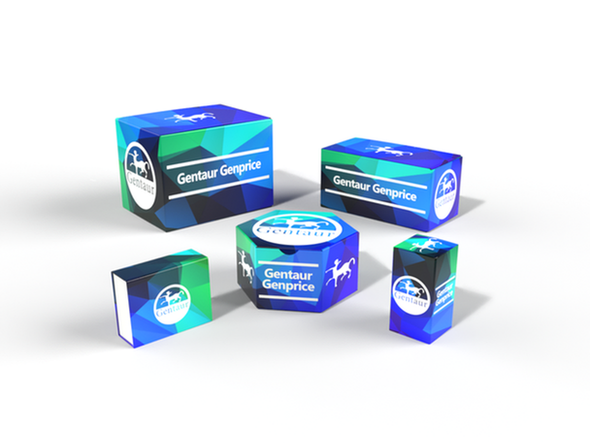Description
CD20 Antibody [CDLA20-1] | 33-937 | Gentaur UK, US & Europe Distribution
Host: Mouse
Reactivity: Human
Homology: N/A
Immunogen: Recombinant CD20 protein was used as the immunogen for this CD20 antibody. The epitope is known to be extracellular.
Research Area: Cancer, Immunology, Signal Transduction
Tested Application: Flow, IF, IHC
Application: Flow Cytometry: 0.5-1 ug/million cells
IF: 0.5-1 ug/ml
Immunohistochemistry (FFPE) : 0.5-1 ug/ml for 30 minutes at RT (1)
Prediluted format : incubate for 30 min at RT (2)
Titering of the CD20 antibody may be required for optimal performance.
1. FFPE testing requires sections to be boiled in pH6 10mM citrate buffer for 10-20 minutes, followed by cooling at RT for 20 minutes, prior to staining.
2. The prediluted format is supplied in a dropper bottle and is optimized for use in IHC. After epitope retrieval step (if required) , drip mAb solution onto the tissue section and incubate at RT for 30 min.
Specificiy: N/A
Positive Control 1: N/A
Positive Control 2: N/A
Positive Control 3: N/A
Positive Control 4: N/A
Positive Control 5: N/A
Positive Control 6: N/A
Molecular Weight: N/A
Validation: N/A
Isoform: N/A
Purification: Protein G affinity chromatography
Clonality: Monoclonal
Clone: CDLA20-1
Isotype: IgG2a, kappa
Conjugate: Unconjugated
Physical State: Liquid
Buffer: PBS with 0.1 mg/ml BSA and 0.05% sodium azide
Concentration: 0.2 mg/mL
Storage Condition: Aliquot and Store at 2-8˚C. Avoid freez-thaw cycles.
Alternate Name: B-lymphocyte antigen CD20, B-lymphocyte surface antigen B1, Bp35, Leukocyte surface antigen Leu-16, Membrane-spanning 4-domains subfamily A member 1, CD20, MS4A1, CD20
User Note: Optimal dilutions for each application to be determined by the researcher
BACKGROUND: CD20 is a non-Ig differentiation antigen of B-cells and its expression is restricted to normal and neoplastic B-cells, being absent from all other leukocytes and tissues. It is expressed by pre B-cells and persists during all stages of maturation but is lost upon terminal differentiation into plasma cells. The protein passes through the membrane 4 times with both ends in cytoplasm and exposes one short and one longer loop to the external environment. It acts as a calcium channel involved in B-cell activation and cell cycle progression.

![CD20 Antibody [CDLA20-1] CD20 Antibody [CDLA20-1]](https://cdn11.bigcommerce.com/s-1rdwiq712m/images/stencil/608x608/products/484143/489972/gentaur-genprice__26005.1661610467__29809.1661628092__75433.1661676199__77988.1661684280__64362.1661692443__02085.1662049603__45075.1662119302__91744.1662191540__21580.1662291419__92782.1663498824.png?c=1)

![CD20 Antibody [SPM618] CD20 Antibody [SPM618]](https://cdn11.bigcommerce.com/s-1rdwiq712m/images/stencil/590x590/products/483560/489389/gentaur-genprice__26005.1661610467__29809.1661628092__75433.1661676199__77988.1661684280__64362.1661692443__02085.1662049603__45075.1662119302__91744.1662191540__21580.1662291419__61354.1663498732.png?c=1)
![CD20 Antibody [B9E9] CD20 Antibody [B9E9]](https://cdn11.bigcommerce.com/s-1rdwiq712m/images/stencil/590x590/products/483377/489206/gentaur-genprice__26005.1661610467__29809.1661628092__75433.1661676199__77988.1661684280__64362.1661692443__02085.1662049603__45075.1662119302__91744.1662191540__21580.1662291419__02270.1663498704.png?c=1)
![CD20 Antibody [IGEL/773] CD20 Antibody [IGEL/773]](https://cdn11.bigcommerce.com/s-1rdwiq712m/images/stencil/590x590/products/483563/489392/gentaur-genprice__26005.1661610467__29809.1661628092__75433.1661676199__77988.1661684280__64362.1661692443__02085.1662049603__45075.1662119302__91744.1662191540__21580.1662291419__36600.1663498733.png?c=1)

![CD20 Antibody [93-1B3] CD20 Antibody [93-1B3]](https://cdn11.bigcommerce.com/s-1rdwiq712m/images/stencil/590x590/products/483561/489390/gentaur-genprice__26005.1661610467__29809.1661628092__75433.1661676199__77988.1661684280__64362.1661692443__02085.1662049603__45075.1662119302__91744.1662191540__21580.1662291419__04535.1663498733.png?c=1)
![CD178 Antibody [NOK-1] (Biotin) CD178 Antibody [NOK-1] (Biotin)](https://cdn11.bigcommerce.com/s-1rdwiq712m/images/stencil/590x590/products/464551/470380/gentaur-genprice__26005.1661610467__29809.1661628092__75433.1661676199__77988.1661684280__64362.1661692443__02085.1662049603__45075.1662119302__91744.1662191540__21580.1662291419__20462.1663495418.png?c=1)

